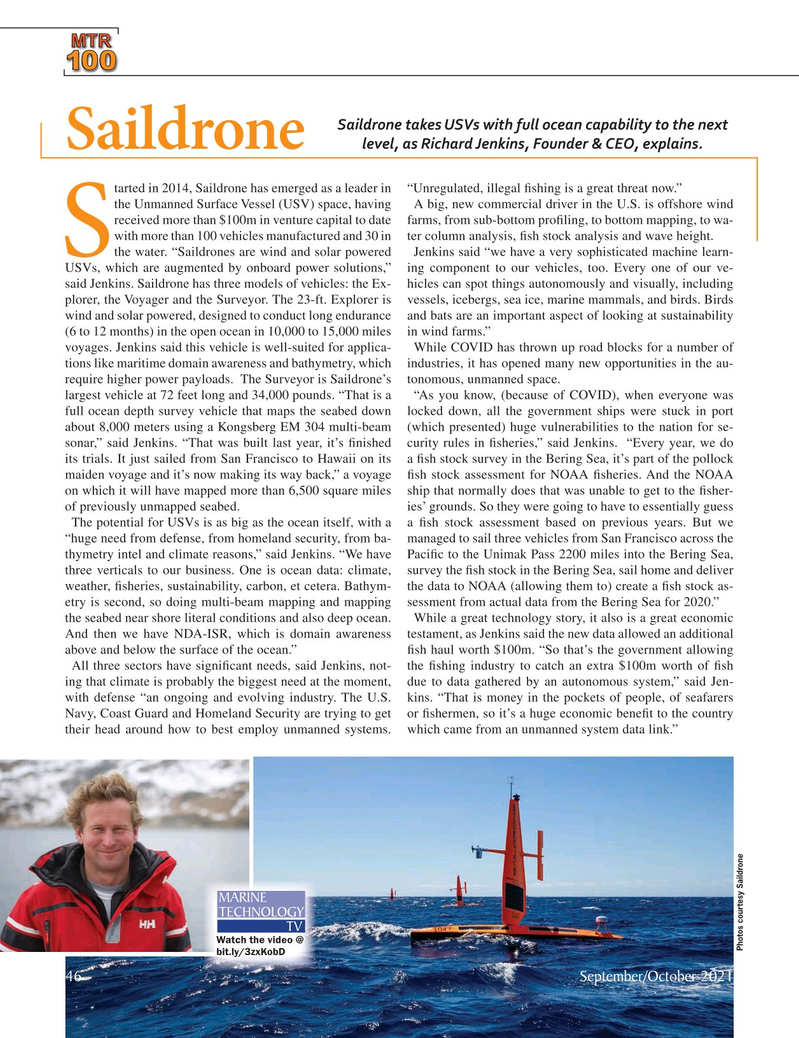
Page 46: of Marine Technology Magazine (September 2021)
MTR100: Focus on 100 Leading Companies, People and Innovations in the Subsea Space
Read this page in Pdf, Flash or Html5 edition of September 2021 Marine Technology Magazine
MTTTTTTTTTTTTTRM M M M M M M M M M M M M M M M M M M M M M M M M M M M MTRRRRRRRRRRRRRRRRRRRRRRRRRRRMTTTTTTTTTTTTTRMTR 100000000000000001111111111111111111111111111100000000000000000000000000000010000000000000000100
Saildrone takes USVs with full ocean capability to the next level, as Richard Jenkins, Founder & CEO, explains.
Saildrone tarted in 2014, Saildrone has emerged as a leader in “Unregulated, illegal ? shing is a great threat now.” the Unmanned Surface Vessel (USV) space, having A big, new commercial driver in the U.S. is offshore wind received more than $100m in venture capital to date farms, from sub-bottom pro? ling, to bottom mapping, to wa- with more than 100 vehicles manufactured and 30 in ter column analysis, ? sh stock analysis and wave height.
S the water. “Saildrones are wind and solar powered Jenkins said “we have a very sophisticated machine learn-
USVs, which are augmented by onboard power solutions,” ing component to our vehicles, too. Every one of our ve- said Jenkins. Saildrone has three models of vehicles: the Ex- hicles can spot things autonomously and visually, including plorer, the Voyager and the Surveyor. The 23-ft. Explorer is vessels, icebergs, sea ice, marine mammals, and birds. Birds wind and solar powered, designed to conduct long endurance and bats are an important aspect of looking at sustainability (6 to 12 months) in the open ocean in 10,000 to 15,000 miles in wind farms.” voyages. Jenkins said this vehicle is well-suited for applica- While COVID has thrown up road blocks for a number of tions like maritime domain awareness and bathymetry, which industries, it has opened many new opportunities in the au- require higher power payloads. The Surveyor is Saildrone’s tonomous, unmanned space.
largest vehicle at 72 feet long and 34,000 pounds. “That is a “As you know, (because of COVID), when everyone was full ocean depth survey vehicle that maps the seabed down locked down, all the government ships were stuck in port about 8,000 meters using a Kongsberg EM 304 multi-beam (which presented) huge vulnerabilities to the nation for se- sonar,” said Jenkins. “That was built last year, it’s ? nished curity rules in ? sheries,” said Jenkins. “Every year, we do its trials. It just sailed from San Francisco to Hawaii on its a ? sh stock survey in the Bering Sea, it’s part of the pollock maiden voyage and it’s now making its way back,” a voyage ? sh stock assessment for NOAA ? sheries. And the NOAA on which it will have mapped more than 6,500 square miles ship that normally does that was unable to get to the ? sher- of previously unmapped seabed. ies’ grounds. So they were going to have to essentially guess
The potential for USVs is as big as the ocean itself, with a a ? sh stock assessment based on previous years. But we “huge need from defense, from homeland security, from ba- managed to sail three vehicles from San Francisco across the thymetry intel and climate reasons,” said Jenkins. “We have Paci? c to the Unimak Pass 2200 miles into the Bering Sea, three verticals to our business. One is ocean data: climate, survey the ? sh stock in the Bering Sea, sail home and deliver weather, ? sheries, sustainability, carbon, et cetera. Bathym- the data to NOAA (allowing them to) create a ? sh stock as- etry is second, so doing multi-beam mapping and mapping sessment from actual data from the Bering Sea for 2020.” the seabed near shore literal conditions and also deep ocean. While a great technology story, it also is a great economic
And then we have NDA-ISR, which is domain awareness testament, as Jenkins said the new data allowed an additional above and below the surface of the ocean.” ? sh haul worth $100m. “So that’s the government allowing
All three sectors have signi? cant needs, said Jenkins, not- the ? shing industry to catch an extra $100m worth of ? sh ing that climate is probably the biggest need at the moment, due to data gathered by an autonomous system,” said Jen- with defense “an ongoing and evolving industry. The U.S. kins. “That is money in the pockets of people, of seafarers
Navy, Coast Guard and Homeland Security are trying to get or ? shermen, so it’s a huge economic bene? t to the country their head around how to best employ unmanned systems. which came from an unmanned system data link.”
MARINE
TECHNOLOGY
TV
Watch the video @
Photos courtesy Saildrone bit.ly/3zxKobD 46 September/October 2021
MTR #7 (34-49).indd 46 9/21/2021 8:44:46 AM

 45
45

 47
47
